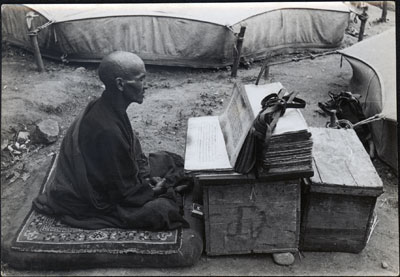
2001.35.300.1 (Print Black & White)


2001.35.300.1 (Print Black & White)

Frederick Spencer Chapman
Evan Yorke Nepean
September 3rd 1936?
Lhasa > Dekyi Lingka
2001.35.300.1
104 x 72 mm
Ritual Activity
Print silver
Loaned August 2002
Judy Goldthorp
British Diplomatic Mission to Lhasa 1936-37
Lady Nepean
CS.7 [view film roll]
Notes on print/mount - 'Lhama reading outside sick man's tent; ink no: 70; pencil no: CS/7; , blue no: '; from an envelope marked 'Scenes during journeys around Lhasa' [KC 14/08/2006]
Manual Catalogues - Caption in Chapman's hand-written list of negatives made whilst on the Mission to Lhasa, 1936-7 [See PRM Manuscripts Collection]: 'Professional prayer outside tents' [MS 14/08/2006]
Other Information - Related Images: Images prefixed with 'CS.' taken on the British Mission to Lhasa 1936-37 comprise a group of negatives containing images of patients from Dr Morgan’s hospital, Mir Khan, curio sellers, bookshops, street scenes, Jokhang, willows and Chapman. They seem to have been taken on or around September 3rd 1936 [MS 14/08/2006]
Other Information - Setting: On October 7th 1936 Richardson described the work of the mission in its quieter moments: "No engagements. We seem to have come into more quiet times and can each return to his respective occupation. Mr Gould, Norbhu and Richardson to their files; Chapman to sorting cinema films and flowers and to writing up bird notes; Dagg and Nepean to overhauling wireless and electrical equipment; and Morgan to his hospital where in a dingy Tibetan room (rather like a stable) lighted by an open well in the roof, he removes cataracts, amputates fingers, gives injections and performs the many other mysteries of his profession. // In front of the hospital is an encampment of tents which the patients with more serious illness, bring and inhabit while under treatment". ['Lhasa Mission, 1936: Diary of Events', part VIII p.3, written by Hugh Richardson][MS 2/4/2005]
Other Information - Cultural Background: An amchi (Tibetan doctor) reading religious texts outside a sick man’s tent. Tibetan doctors both administer herbal medicines and chant appropriate religious texts in an attempt to cure the sick. In this case, the patient may well have first been treated by Dr. Morgan the 1936 Mission doctor as he is recuperating in a British military style tent. Many Tibetans only resorted to Western medicine when all other options had been exhausted. However, surgery for conditions such as cataracts was increasingly requested by Tibetans including monks. [CH 2003]
Other Information - Cultural Background: The tents in this image are relatively modern being made of canvas whereas traditional Tibetan tents are made of yak hair. Leather strap for tying the pages of the book. [TS 31/1/2005]
Other Information - Historical Background: The lama doctors would be trained at the Medical College of Chakpori on the hill adjacent to the Potala Palace. Chapman was very dismissive of Tibetan medical practices in his book Lhasa the Holy City (London: Chatto & Windus, 1938; reprint, London: Readers Union Ltd., 1940, pp. 241-4). He felt that the activities of Dr Morgan, the Mission Doctor, had a significant impact on establishing the success of the Mission as a whole [MS 21/2/2005]
Other Information - Description: Chapman described the making of Tibetan paper and religious texts in his book Lhasa the Holy City [London: Chatto & Windus, 1938; reprint, London: Readers Union Ltd., 1940]. He wrote: "Tibetan paper is made of the bark of daphne or other shrubs. We would often see it being prepared, usually by a man out of doors. He would pound up the bark with water by spreading it on one flat stone and beating it with another. The resulting mixture was then spread on a wooden frame four feet square , over which was stretched fine wire gauze. When dry it was removed from the frame and trimmed. This paper is very tough and coarse and resembles cream-coloured cardboard. Troughs are also used in which the pulp is pounded underfoot. Owing to the poisonous nature of one kind of bark used, no insects will attack Tibetan paper; on the other hand, people who have to spend much time with these books complain of severe headaches. Outside the Potala press we saw a line of men sitting in the sun laboriously cutting out wooded blocks in reverse corresponding to each page, for type is not used in Tibet. These blocks were two to three feet long and about six inches wide. Inside, an enormous hall was taken up with racks holding the sets of blocks" [1940, pp. 176-7] [MS 2/4/2005]
For Citation use:
The Tibet Album.
"Traditional doctor at Mission hospital"
05 Dec. 2006. The Pitt Rivers Museum.
<http://tibet.prm.ox.ac.uk/photo_2001.35.300.1.html>.
For more information about photographic usage or to order prints, please visit the The Pitt Rivers Museum.
© The Pitt Rivers Museum